How To Run A T Test On Excel
Did you know that yous tin perform a t-test in Microsoft Excel? In fact, in that location are quite a few ways to perform a t-examination in Excel. The first utilises the Data Analysis plug-in, while the second option can be used by entering a direct Excel formula. Here I volition explain how to practice both.
Method one: Using the Data Analysis plug-in
Installing the Data Analysis plug-in
The starting time thing you need to do is make sure you have installed the Information Assay plug-in in Microsoft Excel.
To exercise this, go to 'File > Options'. In the new window, become to 'Add-ins':
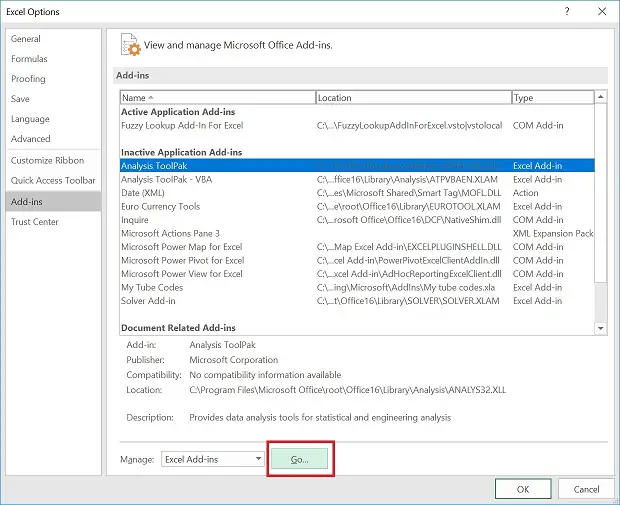 In the new window, check the 'Analysis ToolPak' and click 'OK'.
In the new window, check the 'Analysis ToolPak' and click 'OK'.
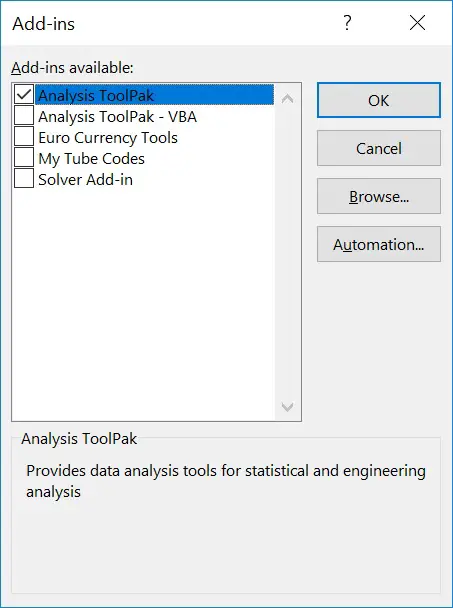 The Information Analysis tin be found under 'Data > Data Analysis':
The Information Analysis tin be found under 'Data > Data Analysis':
 Performing t-tests via the Data Analysis plug-in
Performing t-tests via the Data Analysis plug-in
one. To perform a t-test in Microsoft Excel by using the Data Analysis plug-in, first create 2 columns of data. Each cavalcade should contain the values listed for each experimental group. For this guide, I will compare height (measured in cm) betwixt a group of male and female participants.
This is how my data looks in Excel:
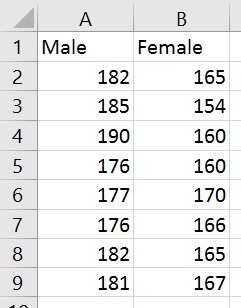 2. Next, go to 'Data > Data Assay'.
2. Next, go to 'Data > Data Assay'.
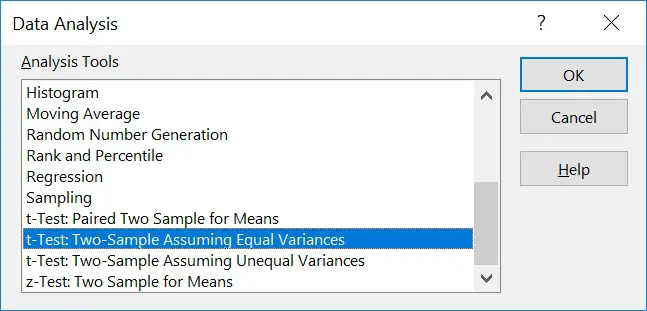 Select the t-examination that is applicable to your data. There are three choices, each of which are described in more detail beneath.
Select the t-examination that is applicable to your data. There are three choices, each of which are described in more detail beneath.
- Paired Two Sample for Ways – A paired (dependent) t-examination; used when analysing data from two related groups.
- Two-Sample Assuming Equal Variances – An independent t-test; used to analyse data from two unrelated groups when the variance of the information within the groups are equal (ie the standard deviations are roughly the same).
- Ii-Sample Bold Unequal Variances – An independent t-exam; used to analyse data from two unrelated groups when the variance of the data within the groups are unequal.
If y'all are unsure as to whether your data has an equal variance or non, first perform an F-test inside Microsoft Excel.
three. For this example, I will select the 't-Exam: Two-Sample Assuming Equal Variances'. Since I am interested in comparison data between two contained groups. I volition presume the variance is equal between both groups.
A new window will appear to let you to select the information for each group. These are entered into the 'Variable i Range' and 'Variable 2 Range' sections. If your information contain headers, so tick the 'Labels' option.
Next, select the alpha you would similar to use. The blastoff is the level of significance, usually gear up at 0.05 (five%).
Also, select where you would like the results to be displayed. In this example, I selected 'Output Range' and selected an empty jail cell next to the data.
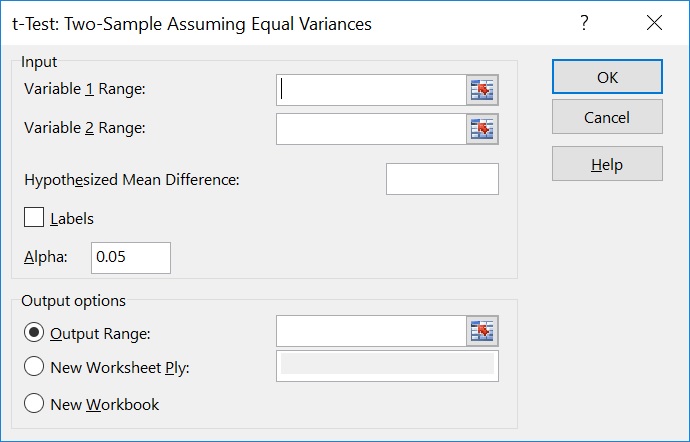 The output
The output
The output of the statistical test given is more informative than using the T-examination formula directly, which only gives you lot the P value.
Beneath is an example of the output produced when using my instance dataset.
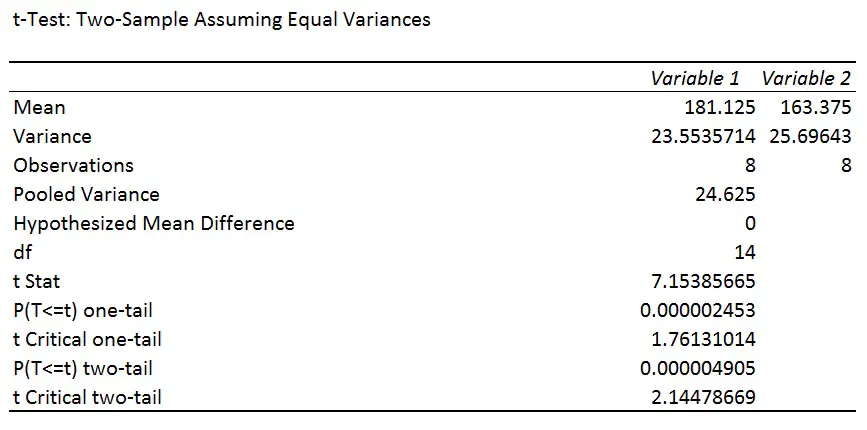 The results can be broken downwards into the following sections:
The results can be broken downwards into the following sections:
- Hateful – The average value for each experimental grouping.
- Variance – The statistical variance of the data for each experimental grouping.
- Observations – The number of samples in each experimental group.
- Pooled variance – The average statistical variance between the two experimental groups.
- Hypothesized hateful difference – If you have selected a hypothesized mean divergence (which we didn't).
- df – The degrees of freedom for the examination. This is the number of values in the final calculation that may vary independently.
- t Stat – The T statistic.
- P(T<=t) 1-tail – The P value, if you are using a one-tailed analysis.
- t Critical one-tail – The T statistic cut-off value when using the one-tailed analysis.
- P(T<=t) two-tail – The P value, if yous are using a two-tailed assay.
- t Disquisitional ii-tail – The T statistic cut-off value when using the two-tailed analysis.
Interpretation
In the example, the aught hypothesis was:
"In that location is no difference in height between the males and females."
The alternative hypothesis was:
"At that place is a difference in pinnacle between the males and females."
Since I have non pre-specified which grouping is higher or lower than the other in the hypothesis, I will look at the output for the two-tail analysis.
Past looking at this example, we tin run across that the P value for the two-tail assay is '0.000004905', which is plain less than our significance level (P<0.05). Therefore, nosotros turn down the null hypothesis and accept the culling hypothesis.
Method two: Using the TTEST role
In that location is an culling fashion to perform a t-examination within Microsoft Excel, by using the T-Test part. Compared to the offset method, the output after using the TTEST role merely produces the P value for the exam.
- To perform the TTEST part, first select the cell where y'all want to insert the concluding output (the P value). Next, click 'Formulas > Insert Function'.
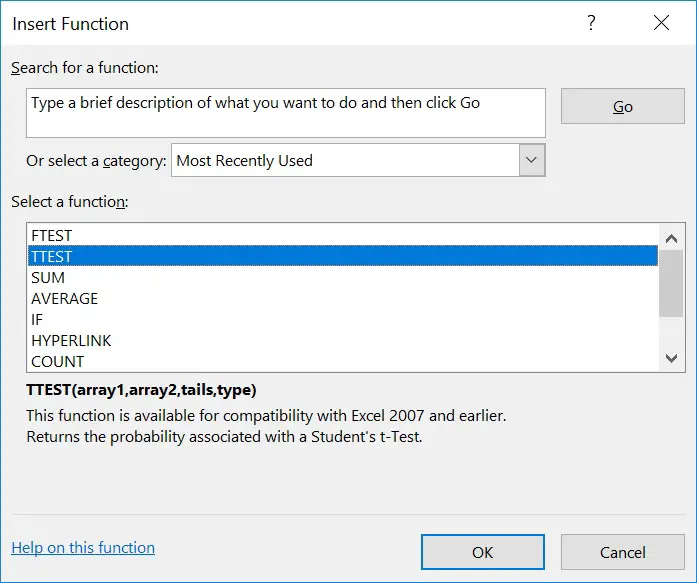 2. Curlicue through the functions until you find 'TTEST' and click 'OK'. A new window will open:
2. Curlicue through the functions until you find 'TTEST' and click 'OK'. A new window will open:
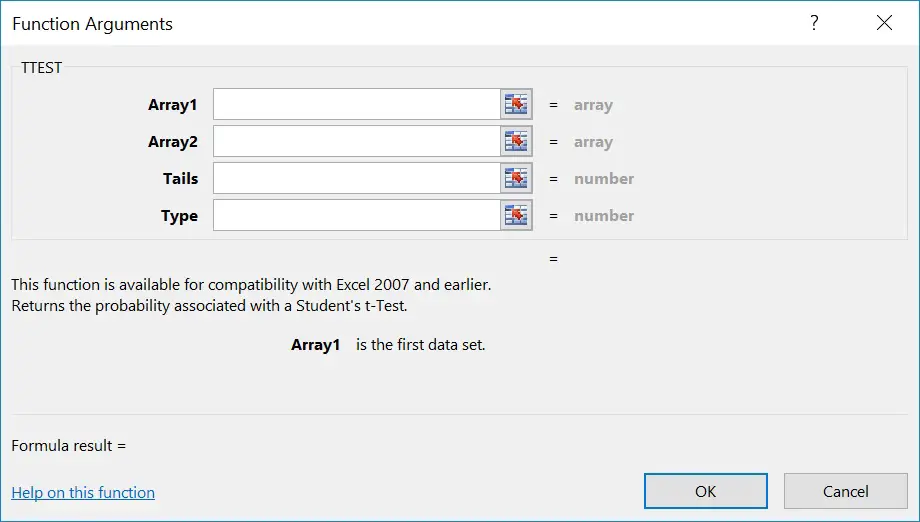
Next, make full in the four required fields:
- Array1 – The data range for the first experimental group.
- Array2 – The data range for the second experimental grouping.
- Tails – The number of tails for the assay
- 1 = One-tailed analysis
- 2 = Ii-tailed analysis
- Type – The type of t-test to perform. Options include:
- 1 = Paired Two Sample for Means
- 2 = Ii-Sample Bold Equal Variances
- iii = Ii-Sample Bold Unequal Variances
Press 'OK' to perform the test. You will now see the P value for that required test in the chosen prison cell.
Conclusion
In this detailed how-to guide, I have explained how to perform t-tests past using Microsoft Excel. At that place are two main ways to exercise this: through the Information Analysis plug-in or direct through the TTEST function.
Source: https://toptipbio.com/t-tests-excel/
Posted by: moodytings1993.blogspot.com


0 Response to "How To Run A T Test On Excel"
Post a Comment